At the end of our last blog, we’d managed to successfully get the pistons in the hydrolocked engine moving. Or so we thought. When we reassembled the engine block head and tried to turn the engine over again, it seemed sluggish and we could hear an ominous squeak. So, what next for our broken sailboat engine?
We’d done all we could with the engine in-situ, so the next step was to have it lifted out of the boat. With that we’d have better access to work on its components. However, time then got away from us as illness and life demands ate up our resources. As a consequence, it wasn’t until the end of December that we were finally ready to have the engine lifted.
With the engine sat on a pallet in a shed, we got out first really good look at it. Initial thoughts were that we could still see a lot of rust. Was it terminal or could we bring Victor the Volvo back to life?
From our social media postings, we’ve had a few questions and suggestions for solutions, so I thought we’d document our options.
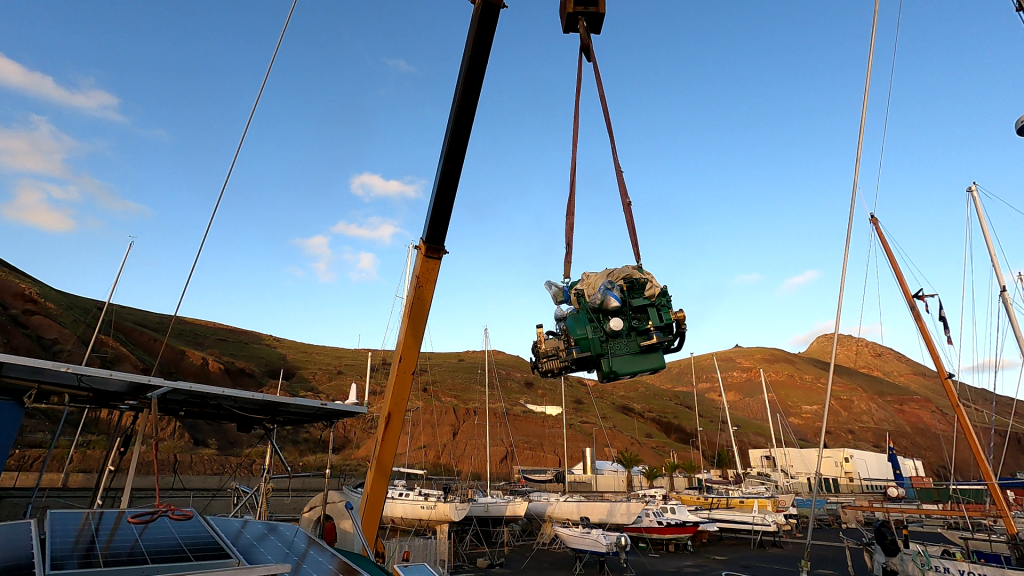
Option 1. Fix the Existing Engine
This is our ideal and least cost solution. We already have a rebuild kit that includes four new pistons and the big end and crankshaft bearings. On the down side, due to our location we are limited by a lack of equipment and services on this tiny island. This means it’s down to us to learn, and then do. Daunting but not beyond the realms of possibility. To quote JT: “after all it’s only nuts and bolts”.
Ideally, we would take the engine block and crankshaft to experts who can assess, clean and restore it if possible. However, we are hampered by a lack of machine shops. Could we send it away – yes. Would it be cost effective? We don’t know.
Also, parts that we have ordered in have taken up to 6 weeks to arrive. It’s a lesson in patience, but the yard is affordable so time isn’t too much of an issue. Other than our own desire to get adventuring again!
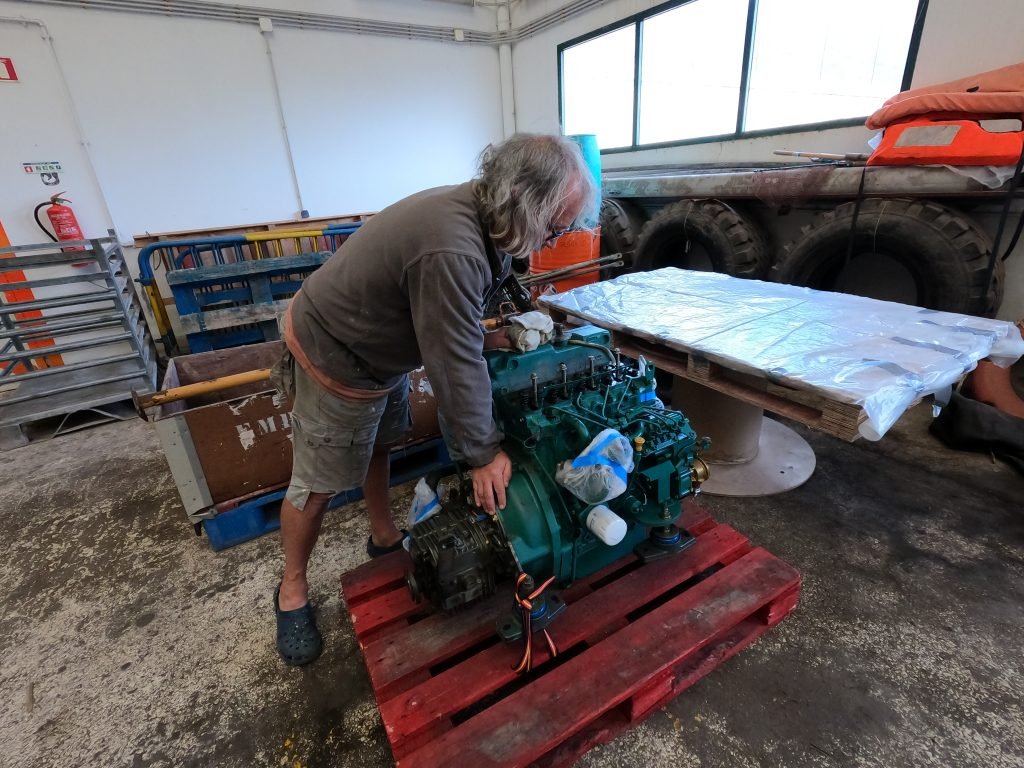
Option 2. Replace With a Second Hand or Refurbished Replacement Engine
We’re keeping an eye on a possible second hand unit as well as searching for others that come up for sale. Although this is a lower cost option than a new engine, there is the question of a second hand engine’s unknown history vs the devil we know.
Option 3. Replace With a New Engine
For many this would seem like the simplest solution. To replace like with like, a new Volvo Penta D2-75 will cost approx. £15k. We think it’s best to stick with the same model of engine to ensure compatibility with the other engine systems. The current engine was installed in 2006, after the Perkins Emerald came with suffered a problem during her delivery passage. It subsequently became very badly rust damaged and although we tried, we just couldn’t easily get replacement parts for it in the UK. Despite having well paying jobs back then, the engine cost still pushed our escape plans back a couple of years. We don’t have the option of well paid jobs now, so we’re reluctant to take this path as it would leave a huge dent in our savings.
Since buying the Volvo, a newer model has been released which has an MDI electronic control box. This seems to be a unit that fails regularly, cannot be repaired and is costly to replace. So an older, non-MDI model would be ideal for us.
For options 2 and 3, we’d strip Victor for spares, such as the turbo (new in 2021) and the stainless steel exhaust elbow.
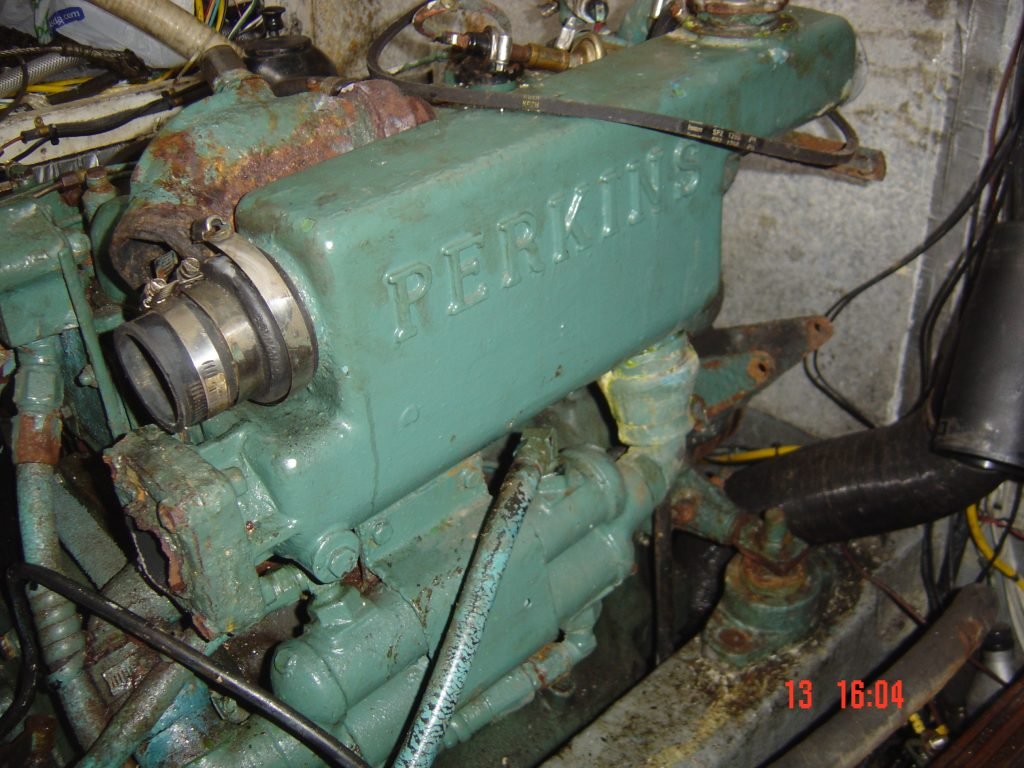
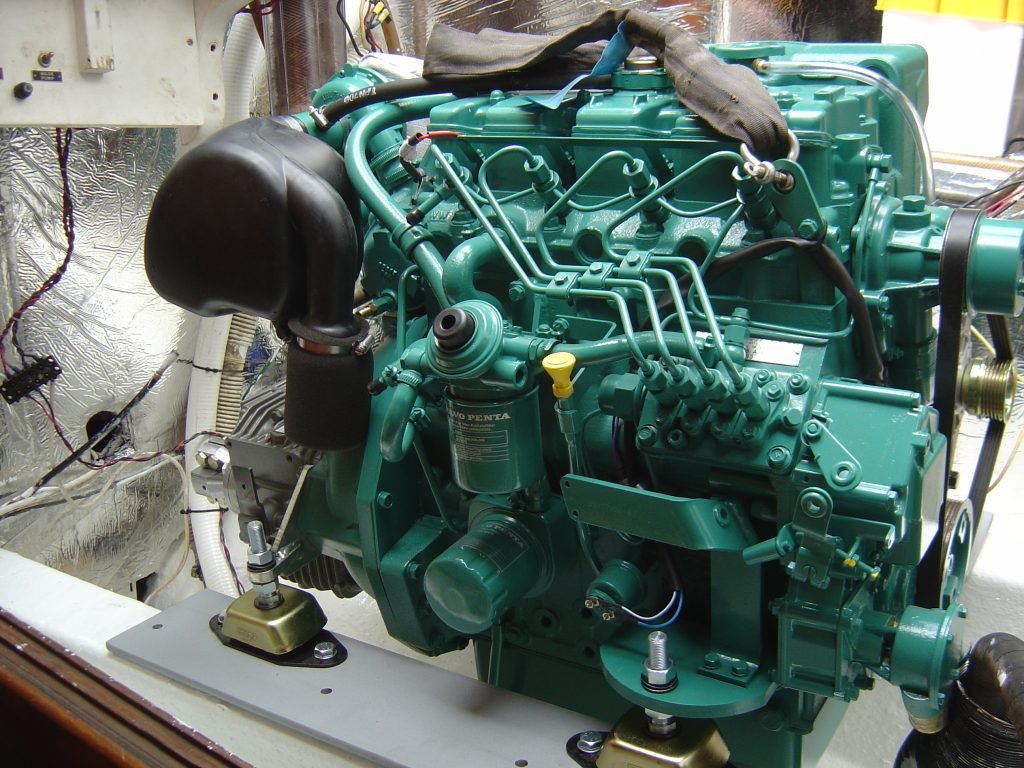
Option 4. Replace the Engine Block with a Perkins 404D 22T
Although badged as a Volvo Penta, the engine is actually a marinised Perkins 404D22T. These engines are commonly used in small, industrial vehicles such as diggers and skid steers. This makes them readily available. We’d salvage all the bolt-ons required for marinising from Victor and install them on the Perkins. These components include the gearbox, heat exchanger, water pump, exhaust and turbo, etc. We need to do more research to ensure the blocks are 100% interchangeable, but this could be a great solution. However, it involves a vast amount of work, both stripping and reassembling.
Also, sensibly priced after-market spare parts are available for the Perkins. Maybe we could replace the rusty crankshaft with a new one?
Option 5. Go Electric
Wouldn’t it be fabulous to replace the diesel engine with an electric one? No noise, no fumes, no mess. Minimal running costs and huge amounts of space freed up by the removal of the diesel tanks. So we did some research, reading blogs and magazine articles and watching YouTube videos on existing sailboat electric installations. Then we did some calculations for what we would need.
The Numbers
- Emerald is 44′ (13.4m) and weighs 17 tonnes.
- To provide a practical amount of power we’ve estimated we’d need a 20kW, 48V motor. We don’t mind motoring slowly but we don’t want to compromise safety by not having enough power to get out of an emergency situation.
- To power a 20kW 48V motor for 1 hour requires 500amps.
- Lithium is available as 100aH 48V units – we’d need a minimum of 5 batteries dedicated as the engine bank.
- Every amp hour of battery needs approx. 2W of solar to recharge. This takes into account that charging such high voltages with solar is tricky because of the imperfections of placing panels on a sailboat – for example shading from the mast.
- To charge the batteries back up in 1 hour would require 4000W of solar. Practically we wouldn’t need to recharge that quickly so we could get by with less. We currently have 850W for our day to day living. If we upgraded to modern technology, we reckon we could squeeze in a total of 1.8kW of panels. We do have plans for a solar upgrade, but not for this level of capacity.
The Equipment
So, we’d need a new motor, solar panels, and batteries. Plus ancillary products such as a charge controller, wiring, and motor controller. Very quick estimates put the cost of an off the shelf kit at £25k.
Maybe we could pare back on the motor size. This in turn would reduce the battery requirements, but that would limit range and leave us with safety concerns. Imagine being at anchor in a big blow and another boat drags into us at night and trips us. And the engine batteries hadn’t recharged because we’d motored into the anchorage in the evening, leaving us power limited. Maybe you’re thinking we have far too over-active imaginations. But in the 9+ years that we’ve been liveaboards, we have experienced some hairy situations in busy anchorages where conditions have changed suddenly. In those moments, engine power was critical for keeping ourselves from danger.
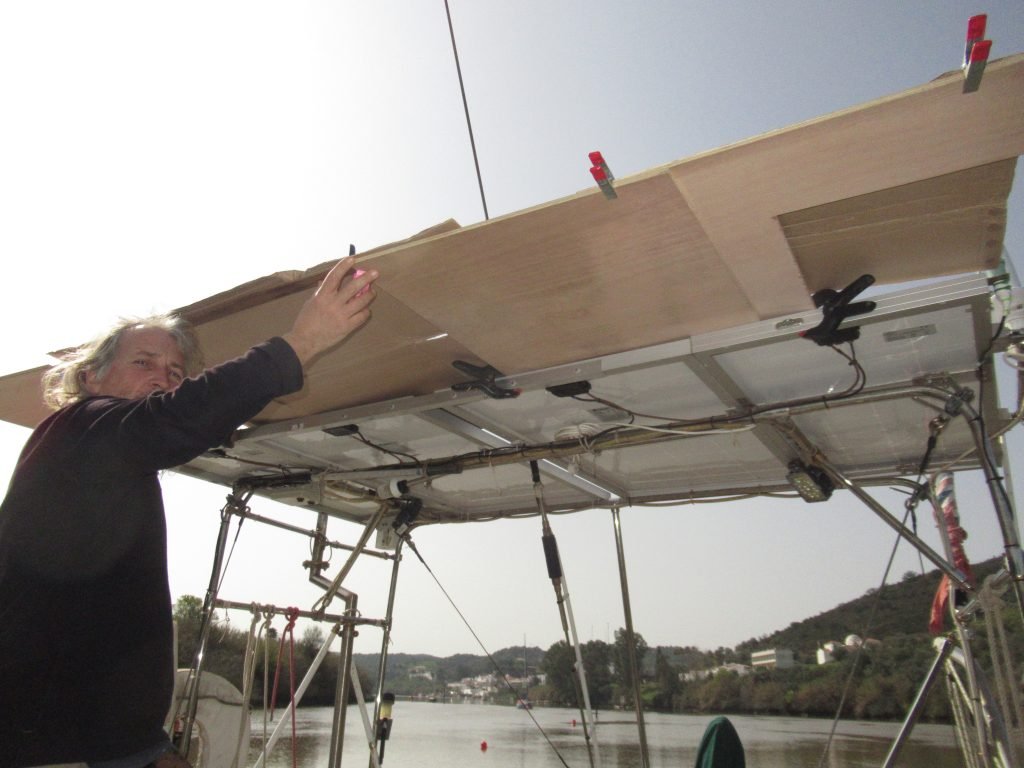
Our Conclusions on Electric Propulsion
All the information we’ve found so far on electric sailboat conversion has been for boats that are smaller or lighter than Emerald. New build electric yachts are being designed to be lighter. The experts recommend a hybrid electric/diesel generator model for Emerald’s size and our range/power requirements. But why would we go to all the expense of the electric motor to also have the need for a diesel generator system onboard?
The reality is that the cost and range/power concerns of going electric for propulsion are just too impractically high for us at the moment. Yep, everything’s simpler with a smaller boat, but we have what we have and we like her. We can hope that prices come down and technology keeps on improving to make this a viable possibility in the future.
Option 6. Give Up!
Give up and sell the boat at a much reduced price for someone else to sort out. There have been times over the last few months when we have felt like just walking away. But we like this lifestyle (well, most of the time!) and when we think about what our alternatives are, it makes us determined to find a solution.
Option 7. Anyone Have Any Other Suggestions?
Maybe there’s something we’ve missed? We’re open to suggestions.
What Next for our Broken Sailboat Engine?
It’s certainly been a rollercoaster ride of emotions over this engine. For example, the aim this week was to remove the crankshaft. The work involved proved the motto “try, try and try again” to be very true. Having disassembled each end of the crank case, we were so close to removing the crankshaft, but no amount of hammering would make it budge. Colin tried again and it seemed like there was an infinitesimally small amount of movement. Had we imagined it? He hit the timing end again. I kept a close eye on the other side, and yes, I saw movement.
But following that success, the amount of rust that was revealed plummeted us back down. Not only on the crankshaft but in the crank case too. However, an afternoon of scrubbing with diesel and a nylon brush and things are looking more optimistic. It was a good place to end the week on.
In our favour, the boatyard in Porto Santo is affordable so we have the time to keep on plugging away. It would give us a tremendous feeling to be able to bring the engine back to life. Plus, the environmental part of us really wants to restore what we have rather than creating waste. Yep, we realise this sounds oxymoronic when we’re discussing diesel engines, but we like to do our best. However, we could be deluding ourselves!
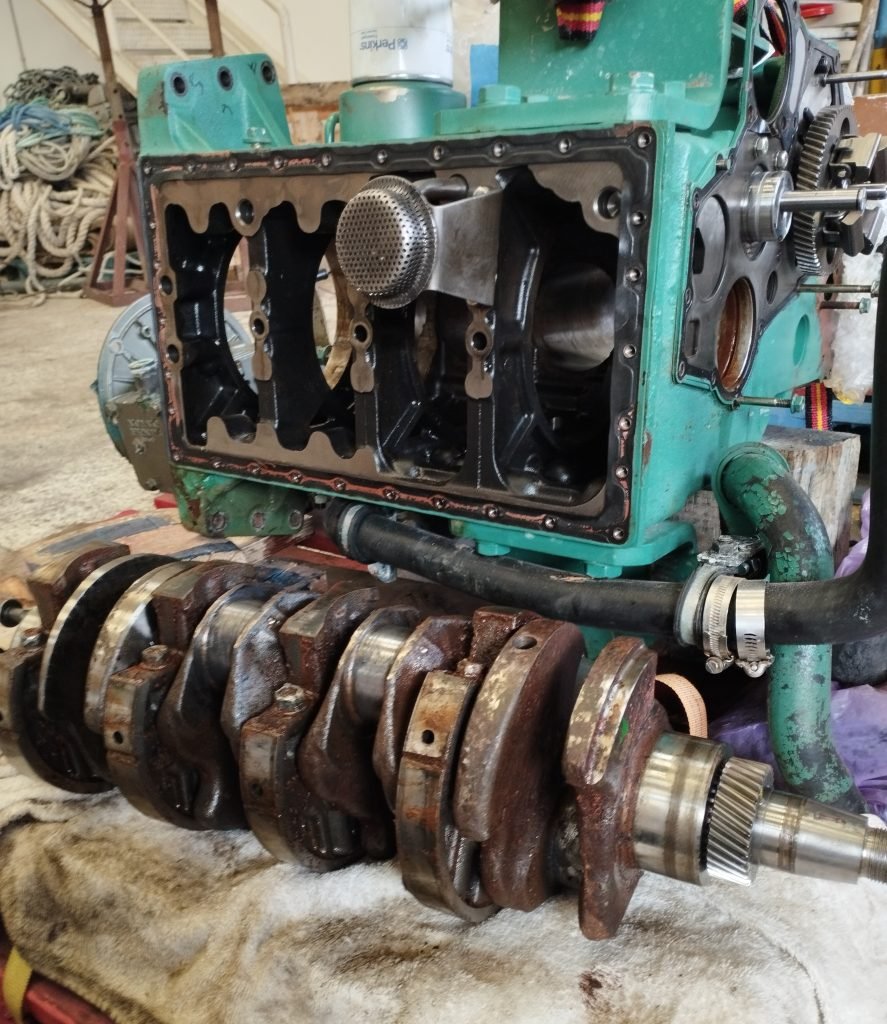
The Social Media Bit: Want to Follow Us?
If you’d like to follow us on other social media platforms (Facebook, Instagram and YouTube), you can do so by using these links:
Or use the link below to track our voyage on NoForeignLand.com.
And finally, you can sign up to receive email notifications of new blogs using the subscribe box at the bottom of this page.
Thank you from Nichola & Colin



What a saga, especially after all the hard work in faro. The engine is not old being new in 2006, so a repair should be viable. I believe the main problem is the lack of expertise in Porto Santo.
However I don´t understand where the problem really is, if it is the squeak that you had after the first repair, and the reason for the full strip down, will that not be sorted when you have cleaned all the oil ports and reassembled?
keyboard acitng up have to end here.
Best wishes for a successful outcome.
Disaster recovery plan, load up and sail for mainland europe.
Hi Paul, yep it’s not been an easy year on Emerald!
Our problem(s) is having found so much rust, can we get it all cleaned up and stop it coming back, and our ability/confidence to assess whether a component has been too damaged or not. We were surprised how well the rust cleaned up so far and we have been able to find some chemicals here to help with that. So, things are looking up.
If the clean up continues to go well, we do intend to put the engine back together with the new pistons and bearings and rig it up to run without putting it back in the boat first.
Here‘s what I would do: Sail (without working engine) to one of the Canary islands. Choose the one with the best options of mechanics and infrastructure you need. Maybe Gran Canaria or Tenerife? Arrange with the harbour or yard or some towing company there that they send someone out to tow you in when you arrive. Once there, you have vastly more access to experts and equipment needed to do the required rebuild. Odering parts will likely also be faster and easier. After all, it‘s a sail boat. You are not immobilized without a working engine.
Hi Matt, we did consider sailing to the Canaries before we were lifted out here. We contacted yards with the services we’d need and found fees are significantly higher than here. So we chose to stay in Porto Santo, although at that time we thought that the engine wasn’t quite as damaged as it turned out to be. But besides that, once we add on engineers labour costs to the yard, tow and crane fees and we’re soon in the same ball park as a reconditioned/second hand engine. Another sailboat arrived here with engine problems and has had a replacement engine delivered, so that still remains an option for us. It just takes more time for deliveries to arrive
I’d suggest investigate crating up, or pallet, and get at least bottom end to UK for assessment, rebuild as reqd. Have you talked to parts4engines? They seem to have access to reconditioning workshop, as sometimes sell rebuilt short-engines, such as my Perkins Prima 4cyl 2 litre … at very attractive prices, fitted with new bearings, pistons etc from their stock. Was about £800 for one to replace mine, and they had a contact to ship to Brittany, somethimg like £140 I think. In the end, I sailed to UK, and rebuilt existing one, as really wasn’t too badly worn, just external corrosion mostly, a light refurb.
The option to substitute block, bottom end, with equivalent Perkins sounds interesting option. BUT … be absolutely sure interchangeable, as Volvo sometimes made irritating mods some Perkins. I’ve heard that Perkins can do surprisingly good prices direct … but I’d also try Parts4engines … and ask around on YBW FORUM, people like Stu Davies can give solid advice, he actually found me replacement crank pulley .. I cracked original with puller!
Wishing you every success … this would be v straightforward, routine obviously in UK … but you know this, sorry … but that seems to be the main challenge, more than the mechanical aspects … stating the obvious, sorry.
Hi Phil, ah didn’t realise parts4engines did refurbs. Useful to know if it comes to that, having plenty of information and options to hand helps with the decisions.
We got a rebuild kit from parts4engines, with new pistons, rings and bearings. Given the low price, we’re guessing it’s because it fits the Perkins body. We’re gathering more info on that too.
We’ve been asking questions and getting advice on a Volvo Penta forum, as we’d forgotten about the YBW one. Today we used diluted phosphoric acid to clean up some components and it’s done a really good job. We’re going to keep on cleaning and see how things look after that
Hi guys,
Wow, what a saga with the engine. We’d hoped you you had it solved. Such is the the life we live. I bet you’ll have a solution soon. You always find a way.
We’re on the hard in Preveza. We have decided it’s time to replace all the skin fittings and seacocks. There are18!!!!
What a job. I have 11 out. I’m not sure what will cost more, the new parts or the medical bills for my bloody knuckles.
Anyway, we all know why we do what we do. We can’t help ourselves. I hope we catch up with you some time. You folks are are great fun. Slainte!
Hello! 18 skin fittings! We thought we had a lot – originally 13, but we’ve got rid of 5. Yeah, we thought we’d fixed the engine, but when we put the head back on and turned it over, there was a very bad squeak, so it had to come out. We’re conducting chemical warfare on the rust and seem to be winning It would be lovely to cross paths again. Good luck with the rest of the fittings, hopefully a nice cold Mythos helps ease the pain away
Hi Nichola,
So I think an acid bath is probably the only solution if you forgive the pun. Hydrochloric is probably the most efficient but not the most environmentally or people friendly. There are products like CLR (popular in Canada) for removing lime and rust on surfaces. This guy uses it on a car engine. Just a thought. https://youtu.be/KNQw8yIys_A
Good luck. Keeping happy thoughts for you guys.
Hi Bruce and Deirdre, thanks for your comment. We’ve been conducting chemical warfare on the crankshaft and crank case and it’s cleaned up really well. We’ve found some other problems – a hole in the gearbox case – that’s delaying us putting the engine back together to see if it runs